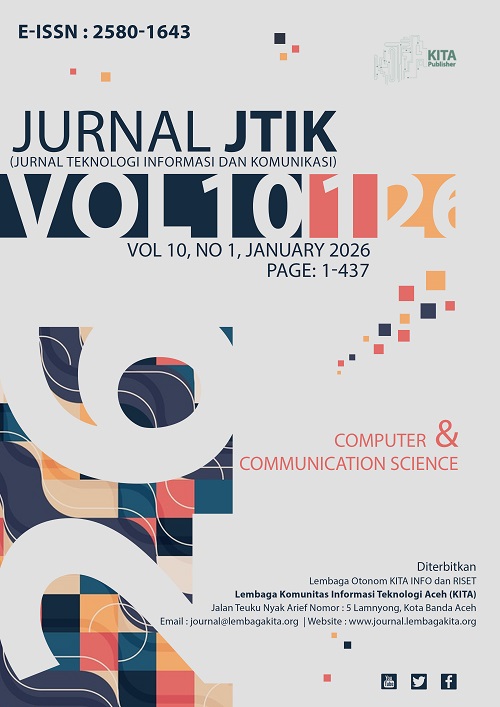Published: 2026-01-01
Representasi Post Traumatic Stress Disorder dalam Film Berbalas Kejam (Analisis Semiotika John Fiske)
DOI: 10.35870/jtik.v10i1.4757
Sheilla Putri Ariyanti, Aulia Rahmawati
- Sheilla Putri Ariyanti: Universitas Pembangunan Nasional “Veteran” Jawa Timur
- Aulia Rahmawati: Universitas Pembangunan Nasional “Veteran” Jawa Timur
Article Metrics
- Views 0
- Downloads 0
- Scopus Citations
- Google Scholar
- Crossref Citations
- Semantic Scholar
- DataCite Metrics
-
If the link doesn't work, copy the DOI or article title for manual search (API Maintenance).
Abstract
Films are not only a medium of entertainment, but also reflect social and psychological issues in society. Film Berbalas Kejam (2023) raises the issue of Post-Traumatic Stress Disorder (PTSD) through the main character named Adam, a victim of violence and a witness to the murder of his wife and child who experienced deep trauma for two years. The study aims to determine how PTSD is represented in this film. The approach used is John Fiske's semiotics, which includes levels of reality, representation, and ideology. The results of the study show that PTSD in the film is represented through 31 scenes that display symptoms such as re-experiencing symptoms, avoidance symptoms, arousal and reactivity symptoms, and cognition and mood symptoms. Cinematic elements such as dark lighting, silent space, and close-up camera composition strengthen the representation of psychological trauma. Ideologically, this film raises criticism of the system that passively handles victims as a whole, and shows a tendency towards vigilantism as a result of untreated trauma. This research is crucial for understanding how popular media, particularly films, can shape public perceptions of mental health and violence. The findings can also open up discussions about the importance of ethical and accurate representation of psychological conditions in audiovisual media.
Keywords
PTSD ; Analysis Film ; Vigilantism ; Representation of Mental Health
Article Metadata
Peer Review Process
This article has undergone a double-blind peer review process to ensure quality and impartiality.
Indexing Information
Discover where this journal is indexed at our indexing page to understand its reach and credibility.
Open Science Badges
This journal supports transparency in research and encourages authors to meet criteria for Open Science Badges by sharing data, materials, or preregistered studies.
How to Cite
Article Information
This article has been peer-reviewed and published in the Jurnal JTIK (Jurnal Teknologi Informasi dan Komunikasi). The content is available under the terms of the Creative Commons Attribution 4.0 International License.
-
Issue: Vol. 10 No. 1 (2026)
-
Section: Computer & Communication Science
-
Published: %750 %e, %2026
-
License: CC BY 4.0
-
Copyright: © 2026 Authors
-
DOI: 10.35870/jtik.v10i1.4757
AI Research Hub
This article is indexed and available through various AI-powered research tools and citation platforms. Our AI Research Hub ensures that scholarly work is discoverable, accessible, and easily integrated into the global research ecosystem. By leveraging artificial intelligence for indexing, recommendation, and citation analysis, we enhance the visibility and impact of published research.




Sheilla Putri Ariyanti
Program Studi Ilmu Komunikasi, Fakultas Ilmu Sosial, Budaya, dan Ilmu Politik, Universitas Pembangunan Nasional “Veteran” Jawa Timur, Kota Surabaya, Provinsi Jawa Timur, Indonesia.
-
-
-
-
-
-
-
-
-
-
-
Patriansah, M., Aini, A., & Fitriani, R. (2023). Semiotika Roland Barthes dalam iklan layanan masyarakat ‘Stop Hoax’ Indosiar. Artchive: Indonesia Journal of Visual Art and Design, 4(1), 92–111. https://doi.org/10.53666/artchive.v4i1.3767.
-
-
-
-
Uyunnisya, M. (2024). Analisis Semiotika Poster Film “How To Make Millions Before Grandma Dies” Berdasarkan Teori Saussure. VisArt: Jurnal Seni Rupa dan Design, 2(1), 229-241. https://doi.org/10.61930/visart.v2i1.685.

This work is licensed under a Creative Commons Attribution 4.0 International License.
Authors who publish with this journal agree to the following terms:
1. Copyright Retention and Open Access License
Authors retain copyright of their work and grant the journal non-exclusive right of first publication under the Creative Commons Attribution 4.0 International License (CC BY 4.0).
This license allows unrestricted use, distribution, and reproduction in any medium, provided the original work is properly cited.
2. Rights Granted Under CC BY 4.0
Under this license, readers are free to:
- Share — copy and redistribute the material in any medium or format
- Adapt — remix, transform, and build upon the material for any purpose, including commercial use
- No additional restrictions — the licensor cannot revoke these freedoms as long as license terms are followed
3. Attribution Requirements
All uses must include:
- Proper citation of the original work
- Link to the Creative Commons license
- Indication if changes were made to the original work
- No suggestion that the licensor endorses the user or their use
4. Additional Distribution Rights
Authors may:
- Deposit the published version in institutional repositories
- Share through academic social networks
- Include in books, monographs, or other publications
- Post on personal or institutional websites
Requirement: All additional distributions must maintain the CC BY 4.0 license and proper attribution.
5. Self-Archiving and Pre-Print Sharing
Authors are encouraged to:
- Share pre-prints and post-prints online
- Deposit in subject-specific repositories (e.g., arXiv, bioRxiv)
- Engage in scholarly communication throughout the publication process
6. Open Access Commitment
This journal provides immediate open access to all content, supporting the global exchange of knowledge without financial, legal, or technical barriers.
